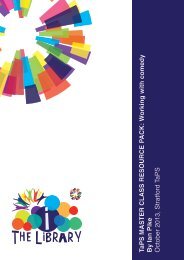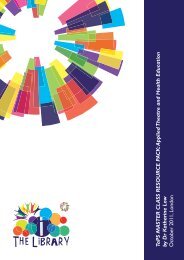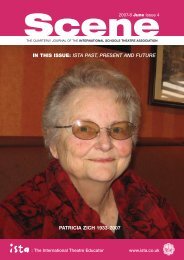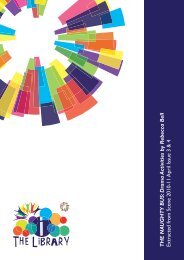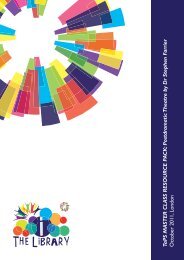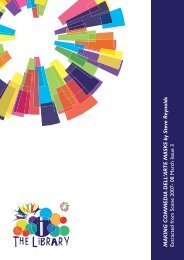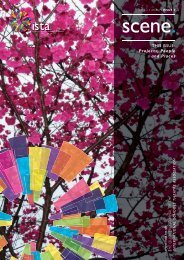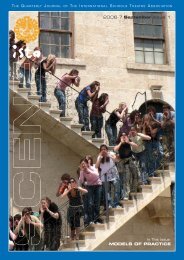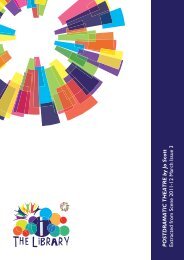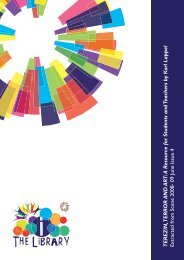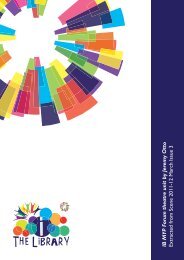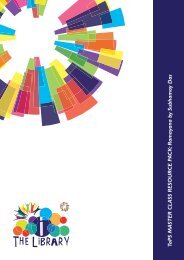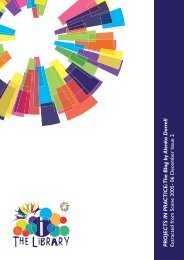ISTA/Scene March 07
ISTA/Scene March 07
ISTA/Scene March 07
You also want an ePaper? Increase the reach of your titles
YUMPU automatically turns print PDFs into web optimized ePapers that Google loves.
“It was wonderful to see young people from all over the globe coming together to further their<br />
learning about theatre in a mutually supportive and excitingly enriching environment.”<br />
Paula Mor, Island School, Hong Kong<br />
THE LADY IS NOT FOR BURNING<br />
by Christopher Fry, published by<br />
Dramatists Play Service<br />
Fry’s play is a beautiful lyrical<br />
exploration of life, love, and morality.<br />
This piece can be done in very<br />
Shakespearean style, with a simple set<br />
consisting of only a couple of raised<br />
platforms and a few benches and<br />
chairs. The small cast has several<br />
women’s roles with some meat to<br />
them, and the roles of the chaplain and<br />
town drunk can be converted, giving a<br />
balance of 6 M to 5 F. The play itself<br />
(written in blank verse) is both a verbal<br />
delight and an effective challenge to<br />
students. Our students revelled in the<br />
unusual word formations and, through<br />
working with the play’s intricate<br />
language, gained greater control of<br />
their own vocal mechanisms. Definitely<br />
a worthwhile challenge.<br />
ORIGINAL VIDEOS<br />
Our Advanced Drama class created<br />
original videos for public presentation.<br />
During class, we concentrated on<br />
three basic elements of filmmaking:<br />
directing, writing, and acting. We<br />
looked at both classic films, such as<br />
Citizen Kane and Casablanca, and<br />
more recent gems, such as American<br />
Beauty. The students, in groups of<br />
about five, pitched a script idea, wrote<br />
a draft screenplay that was critiqued<br />
by the teacher, then revised the<br />
screenplay into a shooting script.<br />
Students then created a locations<br />
chart, shot individual scenes, then<br />
edited them together using iMovie.<br />
Students were both their own actors<br />
and directors, and all students<br />
participated in the editing process. We<br />
had a gala presentation evening. All the<br />
students’ videos were shown, and the<br />
audience voted on Best Supporting<br />
Player, Best Actor, Best Actress, Best<br />
Screenplay, and Best Picture. Winners<br />
received little Smurf statuettes. It was<br />
a great way to cap the project, which<br />
we would recommend as a means to<br />
helping drama students connect the<br />
dots between the two media of theatre<br />
and film.<br />
Annie Mcmanners – Frankfurt<br />
International School, Germany<br />
HOMER’S ODYSSEY by David<br />
Calcutt published by Nelson as a<br />
Dramascript<br />
We worked for 2 months on this with<br />
9-12 grade students. 15 girls and 15<br />
boys. The first scene in the play is<br />
slightly dodgy and could take a few<br />
cuts, but it soon perks up. The girls<br />
played the suitors of Penelope in the<br />
first and last scene wearing masks and<br />
robes and then the boys burst in with<br />
a sort of Haka that was virile and<br />
visceral to lead into the rest of the play.<br />
Masses of music and movement<br />
opportunities, dance, mime and choral<br />
speaking. We performed on the floor of<br />
the room with audience on 3 sides and<br />
a series of platforms and steps leading<br />
up to the stage at one end. The<br />
Cyclops was rear projection with a<br />
voice over, but there are other great<br />
production challenges for IB students<br />
to work on.<br />
GRIMM TALES AND MORE GRIMM<br />
TALES by Carol Ann Duffy and Tim<br />
Supple, published by Faber and<br />
Faber<br />
Each of these contains 7 or 8 different<br />
stories with dramatizations. We<br />
selected 8 scenes from the two plays<br />
and put them together as one<br />
performance. We performed on the<br />
floor with audience on three sides with<br />
large painted screens on either side to<br />
provide exits etc. There was a cast of<br />
50, divided into two groups, but it<br />
could be done with 10 actors. In Act 1,<br />
one group performed as the sound<br />
factory for the stories, sitting apart<br />
from the actors, making sound/music<br />
using a variety of traditional and<br />
improvised instruments as well as their<br />
voices. For Act 2 they swapped with<br />
the other group. Each story has a<br />
different set of challenges and we used<br />
Folkmanis puppets in many instances<br />
as well as creating all of the settings<br />
and props using students. The screens<br />
were painted with a scary forest taken<br />
from a book of Walt Disney stills from<br />
Snow White and the 7 Dwarfs. We<br />
worked for 2 months with students from<br />
grades 9-12.<br />
ARABIAN NIGHTS by Dominic<br />
Cooke, published by Nick Hearn<br />
Books<br />
Rich colour, fabric, carpets, gold and<br />
silver, food platters with real food, belly<br />
dancing, incense burners. This is all<br />
you need to do this show. We had a<br />
large cast of 55 and there are about 40<br />
roles but you could do it with 10, with<br />
doubling. There is a lot of room to<br />
make each story individual and I asked<br />
pairs of IB students to take charge of a<br />
scene, encouraging them to negotiate<br />
with each other to produce an<br />
umbrella design, as well as individual<br />
ideas. The Music department<br />
purchased a number of authentic<br />
Beijing MS<br />
<strong>Scene</strong> | 2006-7 <strong>March</strong> Issue 3 | 15



